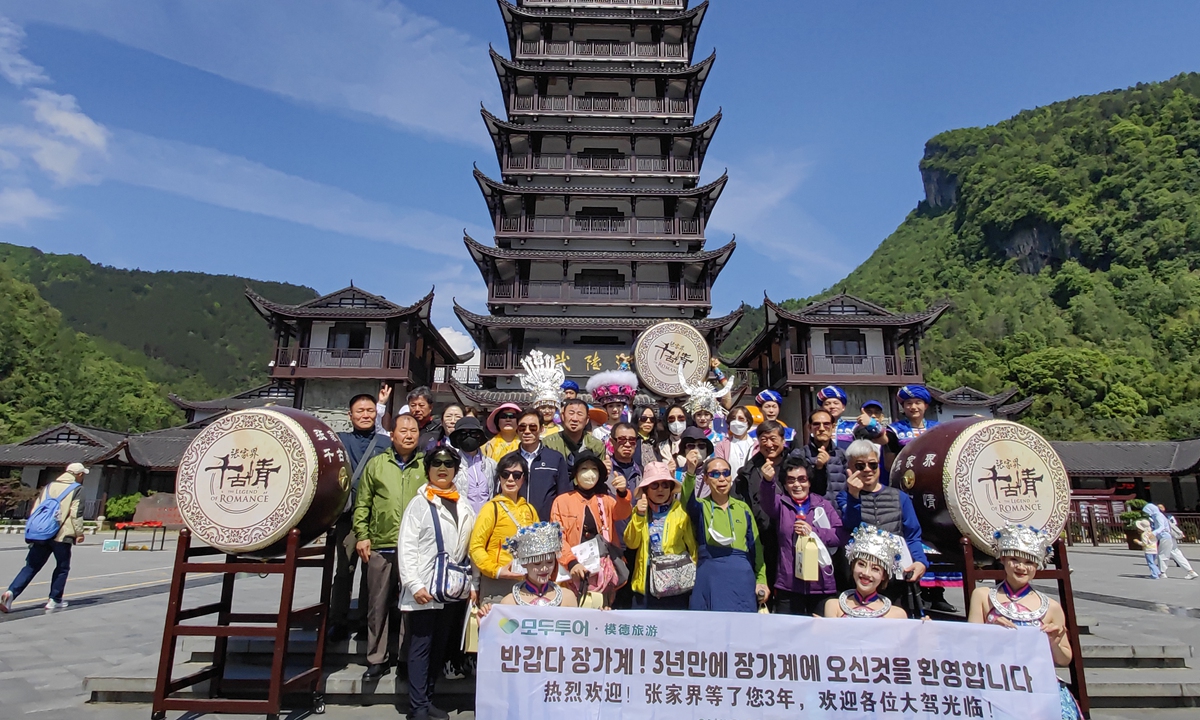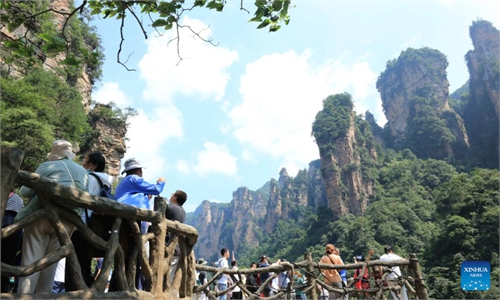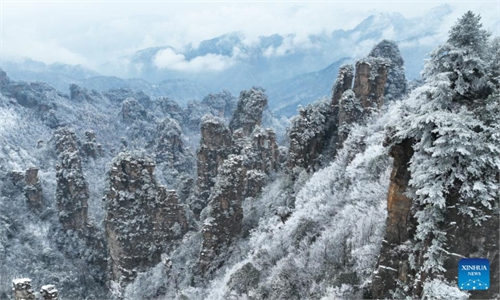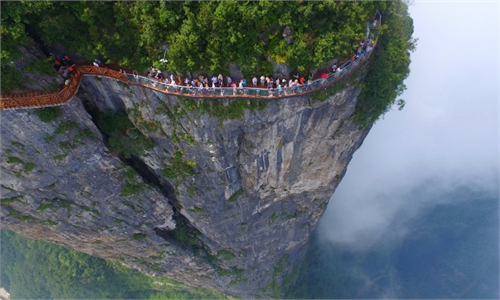ARTS / CULTURE & LEISURE
Why it becomes a paradise for foreign tourists and what experience it can offer for Chinese cities
From Seoul to Zhangjiajie

South Korean travellers pose at Zhangjiajie in 2023. Photo: VCG
After finishing the last spoon of Doenjang jjigae (Korean soybean paste stew) and stepping onto the travel shuttle bus, adorned with a Korean sign guiding the way, an avid outdoor enthusiast prepares to embark on a long-awaited mountain climbing expedition.
The trip's destination, however, isn't a suburb in South Korea nor the mountain range near the Northeast China border, but Zhangjiajie, a city in Central China's Hunan Province renowned for its massive pillar-like rock formations and designated as a UNESCO global geological park. Recently, Zhangjiajie has seen a surge in South Korean visitors.
Data from China Media Group on February 27 showed that the number of South Korean tourists traveling to China in January skyrocketed by 908 percent year-on-year. But instead of the mega-cities such as Shanghai, Shenzhen, or the capital Beijing, Zhangjiajie turned out to be a more attractive choice for their inbound travels. A Zhangjiajie travel agency noted to the media that its orders from South Korean travel groups have been solidly booked through June of this year.
But the fact is, the knot between South Korean visitors and Zhangjiajie started at least 20 years ago. The city, teeming with foreign tourists, has built an international tourism hub that has been thriving for decades offering comprehensive services. Its success may provide an example from which other cities can learn to better attract and cater to international travelers.
20-year-long friendship
When cross-national tourism was still a luxury for most people in China, Zhangjiajie, hidden deep in the Chinese inland, had already established a two-way flow with South Korea at the beginning of the 21st century.
According to the Chinese magazine New Weekly, the city only received 116 South Korean tourists in 1998, accounting for only 2.31 percent of all inbound foreign tourists to China at that time.
But the turning point came in 2001, when Zhangjiajie invited South Korean tourism professionals and officials in November during its International Forest Conservation Festival and promoted the spectacular peak walls to South Korea. And the former started to see a rise of foreign tourism wave that has continued expanding for more than 20 years to this day.
The number of South Korean tourists to Zhangjiajie keeps increasing every year. Data revealed that the city receives an annual average of 200,000 South Korean tourists, which once peaked at 600,000.
Public data show that Zhangjiajie received 690,000 inbound tourists in 2023, with more than 280,000 visitors coming from South Korea, accounting for 40 percent of the total.
In response to this trend, Zhangjiajie has adapted accordingly. Establishing friendly relations with Hadong-gun, a South Korean city, in 2006, and distributing more than 10,000 copies of Korean version of the Tourist Service Guide in 2013 are among the initiatives undertaken. Additionally, the Zhangjiajie Airport now offers direct flights to major South Korean cities such as Daegu and Busan, with travel times of under four hours from Seoul, making weekend mountain climbing excursions abroad easily feasible.
Charm of the mountains
As Korea.net, South Korea's largest governmental cultural tourism promotion website, explains, mountain climbing has become not only a hobby but a part of the culture for South Koreans, thanks to the fact that the mountainous area takes up 70 percent of the country's total landscape.
Some media agencies, including The Washington Post, even described mountain climbing as the "national identity" of South Koreans, inscribed in their cultural DNA.
Therefore, other renowned scenic destinations in China, such as Huangshan Mountain and Jiuhuashan, known for their mountains and rivers, are also filled with South Korean backpackers.
For instance, Huangshan Mountain in East China's Anhui Province has long been the top overseas tourist source for South Korea as well. As early as 2006, the Huangshan Tourism Bureau established an office branch in Seoul, the South Korean capital.
Similarly, Zhangjiajie, a place with more than 3,000 towering peaks, stands out globally for its unique landscape. There are move than 1,000 peaks surpassing 200 meters, categorized into various forms such as peak forests, stone gates and valleys.
This mountainous city precisely captures its characteristics. As a nationally famous scenic area known for its "always being open to novelty" attitude, Zhangjiajie promotes itself as the shooting location of the 2009 epic fantasy sci-fi film Avatar to attract global young tourists.
New task
While Zhangjiajie has long been a popular destination for South Korean travelers, its connection with Chinese tourists largely went unnoticed until a related hashtag gained viral traction on Chinese social media platforms recently.
"It might inspire domestic culture and tourism as well, as many cities are now facing internal competition for more touristic resources, and the overseas market holds great potential as well," Xu Xi'ao, a Beijing-based tourism business insider, told the Global Times.
Since Thursday, China has extended its visa-free policy to more countries, with six new European countries, such as Switzerland, Ireland and Hungary being included this time. This move follows the announcement of a visa-free entry policy for six countries made in November last year.
Last week, the country also released a guideline asking payment entities to facilitate multiple payment measures, including bank cards and cash use, to align with a more standardized payment services internationally.
"These convenient policies are attracting international tourists. But whether a city can seize the opportunity, such as adding multi-national audio broadcasting to public service facilities, is the next step to pay attention to," added Xu.



